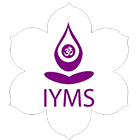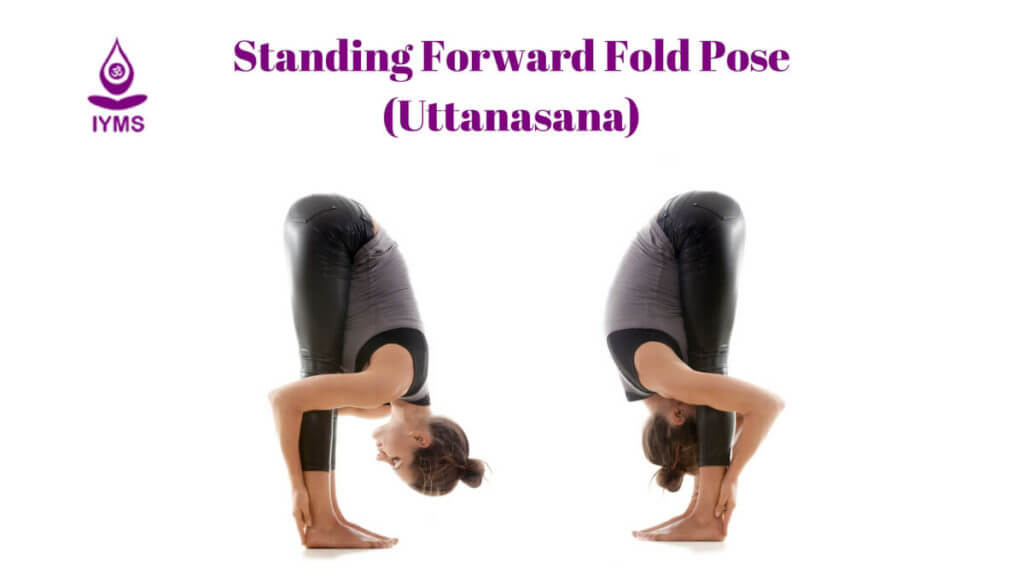Uttanasana is commonly known in English as Standing Forward Bend, Standing Forward Fold, or Standing Head to Knees Pose. The Sanskrit name when divided into three parts translates as “ut” meaning intense, “tan” meaning stretch, and “asana” meaning posture.
This is another semi-inversion pose in yoga, which places the heart above the head, thus benefiting you mentally while working on the physical aspects of the body as well. As the name suggests, the pose is great for stretching your neck, spine, hamstrings, arms, and calves.
Pose Information
- Yoga Pose English Name: Intense Forward-Bending Pose, Standing Forward Bend, Standing Forward Fold Pose, or Standing Head to Knees Pose
- Sanskrit Name: Uttanasana
- Pose Level: Beginners
- Pose Type: Forward Bend
- Strengthens: Thighs and Knees
- Stretches: Hip, Hamstring, Calf
Preparatory Poses
- Downward Facing Dog Pose or Adho mukha śvānāsana
- Seated Forward Bend or Paschimottanasana
- Head-to-Knee Pose or Janusirsasana
- Reclining Hand-to-Big-Toe Pose or Supta Padangusthasana
Follow-up Poses
- Standing poses, seated forward bends, or inversions.
How to do Uttanasana or Standing Forward Fold Pose?
Uttanasana is a basic asana of yoga, yet one is required to be a little careful while performing this yoga asana. Here is the step by step guide to perform standing forward fold pose to get good results:
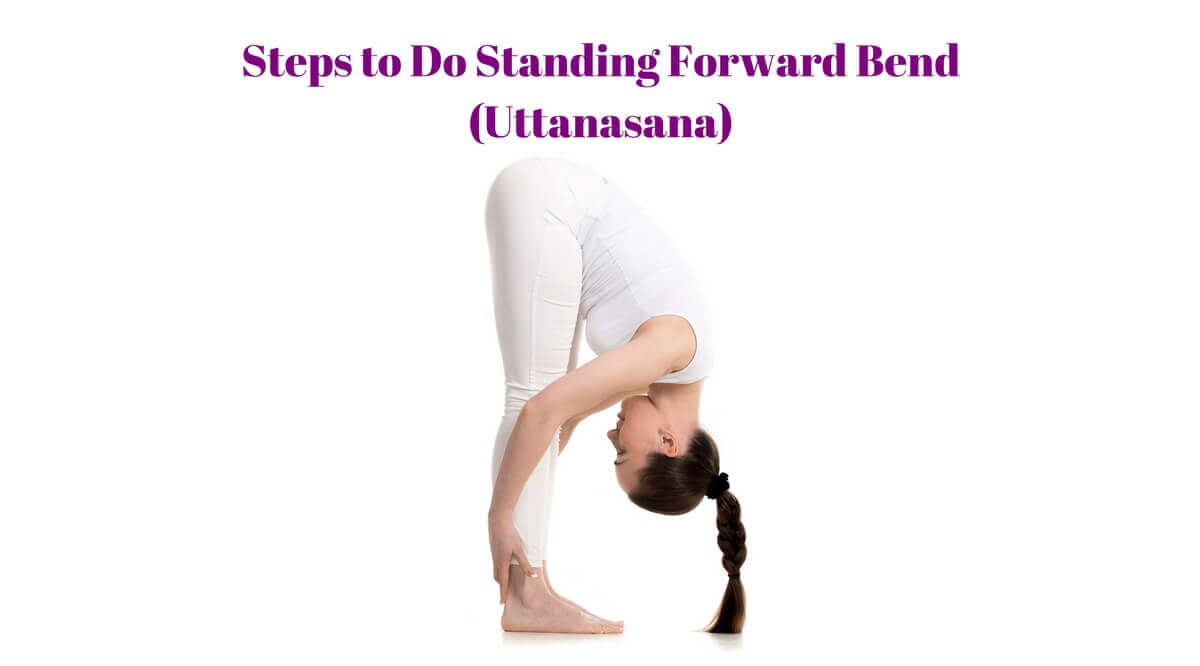
Step 1
Stand in the Tadasana or Mountain Pose, place your hands on your hips. Now exhale and start bending towards the feet from your hip joints, and not from your waist.
As you go down, try to draw your front torso out of the groins in an open space between the top sternum and the pubis. While performing forward bend, the focus should always be on lengthening your front torso while moving more into this pose.
Step 2
If feasible, keeping your knees straight try to touch the floor with your palms or fingertips slightly besides or in front of your feet. You can also bring your palms towards the back of the ankles.
If this poses is not achievable, try holding your elbows by crossing your forearms. Press your heels gently on the floor and raise your sitting bones in the upward direction or towards the ceiling. Now turn your top thighs slightly inwards.
Step 3
With every inhalation in this posture, lengthen and slightly lift your front torso and with every exhalation slightly release towards forward bend. This allows your torso to oscillates nearly imperceptibly with your breath.
Allow your head to hang almost from the root of your neck that is deep in your upper back and in between shoulder blades.
Step 4
This yoga pose is used as the resting pose in between standing poses. Remain in this position for around 30 to 60 seconds. This can also be performed as a pose in itself.
Step 5
Avoid rolling your spine to get back to the original position. Rather, carry your hands back on your hips and reiterate the length of your front torso. Now press the tailbone towards the downward position of the pelvis and come back to standing position with an inhalation.
Benefits of Standing Forward Bend Pose
Uttanasana brings along with it, several health benefits, making it one of the most loved pose, especially for beginners, considering that it is not difficult to master. So, let us move on forward and understand how it be advantageous to our health, mentally, physically, and emotionally.
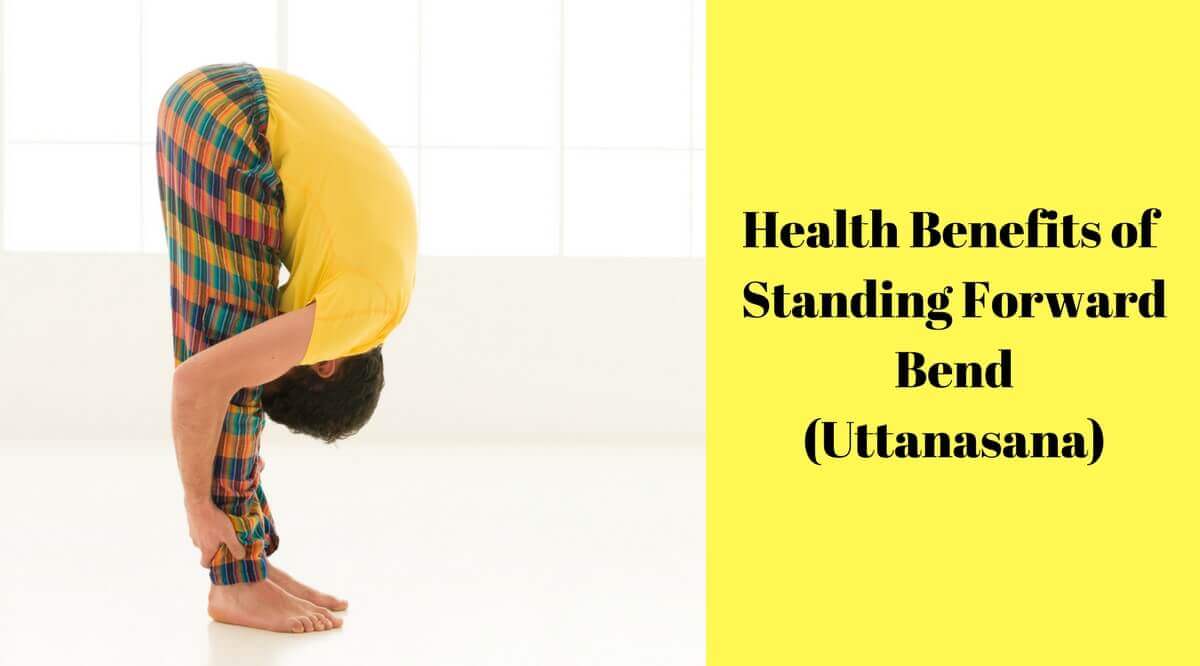
- Bending forward creates pressure in the abdominal area. This results in the toning of the abdominal muscles while also shielding the stomach from aches and ailments. This pressure assists you in toning the spleen, liver, and kidneys. Additionally, the action improves digestion and cures you from problems of constipation.
- The practice and mindful breathing technique helps in learning to breath even in the most difficult positions.
- It improves the spinal nerves as the stretch lengthens the entire ack of the body.
- Since this is a semi inversion, it allows the free flow of blood to the brain, thus ensuring a growth in concentration, less anxiety and depression. The pose is great for students who need to memorize a lot of material before exams.
Other than these major benefits the uttanasana is also beneficial for:
- Curing infertility
- Relieving fatigue
- Curing insomnia
- Getting stronger leg muscles
- Increasing flexibilty of spine
- Soothes nerves and calms the mind.
- Reduces anxiety, stress, fatigue and depression.
- Relieves tension in the neck, back and spine.
Standing Forward Bend Precautions
While this is a beloved pose, mostly because of its simplicity, there are certain precautions to be kept in mind before going ahead with the pose. Some of the prime precautions are:
- Do not practice uttanasana during pregnancy or when you are going through menstrual cycle. The bend puts pressure on the abdominal area and thus can prove harmful during these times.
- If you have a history of any back injury and are still in the healing process it is best to avoid the pose, in case it aggravates the problem. Even if you feel that your back problem is gone, it is still important to tread with care. Hence, it is always best to get in touch with your medical practitioner and only proceed after a go-ahead. The best recommendation would be to practice with the help of yoga blocks.
- Do not try to push yourself beyond your body’s limitations. Yoga is supposed to make you feel good and not stressed. Take each practice session slow and steady and understand your body in the process.
- If you have undergone recent surgery for your abdomen, avoid this pose completely.
- Do not proceed with the practice if you suffer from high blood pressure
- In case you suffer from sciatica, proceed with the practice gently, highly recommended, under the supervision of a teacher. You can perform the Ardha Uttanasana (Half Standing Forward Fold) to make the pose easy for you.
Uttanasana Beginners Tip
Beginners need to proceed with more care with any yoga pose and the same advice applies when practicing uttanasana too. Here are some tips for beginners who are just learning to get into the pose.
- Since you are new to the pose, you need to understand that alignment is important. Hence, when starting off, practice with your back to the wall ensuring that your back, sit bones, and legs are all positioned in one line. Also, this will help you to keep check that your hips do not push backwards when you bend forward.
- Relax your knees as much as possible while doing the pose. You do not have to master straightening your legs from the very start.
- Be mindful of the way you breathe with every step. It will increase the benefits manifold.
- Your back must be straight when you perform the pose, however, in the beginning since your hamstrings are tight, the back might get rounded. Hence, to prevent that from happening, bend your knees deeper if required.
Uttanasana Modifications
Modifications help in attaining the right posture for a yoga pose. Hence, here are some modifications that will help you perform the standing forward fold pose better.

- Balance is important as is alignment in Uttanasana. So, if you find it difficult to balance your body while keeping your feet together, then place a yoga block between your inner lower thighs to help you with the problem.
- Use a blanket to lower the pressure on the feet and reduce stress on the soles.
- Try practicing the pose while seated on a chair or stool. It is like doing it while standing and helps you open the back and the leg muscles.
- You may not be able to reach down to your toes the first few times. In the beginning use yoga blocks in front of you, so that when you bend forward, you can place your hands on them instead of the ground.
Uttanasana Variations
The Uttanasana comes in many variations for you to practice. Here are six of the variations that you can try today.
1. Uttanasana with Twist
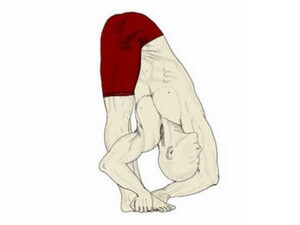 This variation of yoga involves a twist. To attain this position, first follow the simple steps of doing Uttanasana.
This variation of yoga involves a twist. To attain this position, first follow the simple steps of doing Uttanasana.
After you have bent twist your body to the left and then push the forearm slightly against the right leg. Repeat the same to the other side.
This variation of Uttanasana is great for stretching and strengthening the muscles in and around the spine and provides your internal organs a gentle massage.
2. Uttanasana with Clasped Hands (Bandha Hasta Uttanasana)
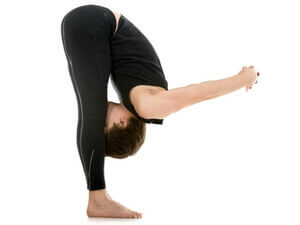 While you are standing in Tadasana, preparing for Uttanasana, spread your legs sideways up to shoulder-width apart and take your hands behind the back. Clasps your hands together, entwining the fingers around each other.
While you are standing in Tadasana, preparing for Uttanasana, spread your legs sideways up to shoulder-width apart and take your hands behind the back. Clasps your hands together, entwining the fingers around each other.
Once ready, hinge forward slowly and raise your arms up as you bend. Do not pressure yourself to extend your hands higher as flexibility will be achieved with practice.
This pose relaxes the shoulders and opens your chest.
3. Reverse Prayer (Paschim Namaskarasana) Uttanasana
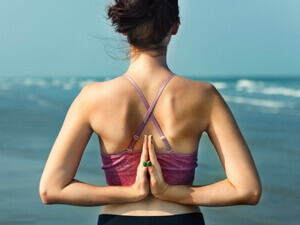 Like the name suggests, the reverse prayer pose is added to Uttanasana. The namaskara will be done behind the back rather than in front, against your chest.
Like the name suggests, the reverse prayer pose is added to Uttanasana. The namaskara will be done behind the back rather than in front, against your chest.
When standing in Tadasana, ensuring that the spine is elongated and straightened, extend both hands behind your back and press the palms together in prayer pose.
Now bend forward with your hips and try to come into Uttanasana with hands in reverse prayer pose.
This variation helps with stretching the shoulders and opening the chest muscles.
4. Elbow Hold (Ardha Baddha Sukha) Uttanasana
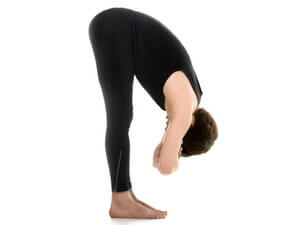 To do this variation, you can start by holding on the left elbow with your right hand and vice versa while you are still in an upright position.
To do this variation, you can start by holding on the left elbow with your right hand and vice versa while you are still in an upright position.
You then proceed doing the Uttanasana while still holding on to the elbows and bend forward from the hips.
Adopting this variation enables you to get rid of a stiff back, caused by the amount of sitting all day at work or classes.
5. Intense Side Stretch Pose (Parsva Uttanasana)
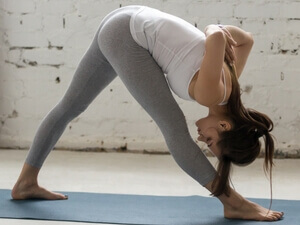 Stand in tadasana and spread your legs and make 90 degrees angle between your two leg.
Stand in tadasana and spread your legs and make 90 degrees angle between your two leg.
Now, turn your left and right feet to right side.
Next, rotate your torso to the right and with an exhale bend forward from the groins over your right leg.
Repeat the same steps with left side.
6. Wide-Legged Forward Bend (Prasarita Padottanasana)
 Stand straight and spread your legs apart as far as you feel comfortable. Now, hinge forward into Uttanasana.
Stand straight and spread your legs apart as far as you feel comfortable. Now, hinge forward into Uttanasana.
In this pose you can touch your feet with your hands or keep your arms in reverse prayer pose.
This pose give a good stretch to your lower back and upper thigh muscles.
Conclusion
If you have not started with the Uttanasana then you must try it because of the one-stop health solutions it offers. As simple as the pose looks, it still is an intense workout offering holistic value to our body.
The standing forward fold pose is very helpful to strengthen your spine. This yoga pose allows blood to rush towards the head (instead of feet), which offers a rejuvenating boost to the braincells with oxygen.
So, wherever you maybe, especially when you are tired and de-energised, try the Uttanasana. It is the way to a rejuvenating and energizing day ahead.
